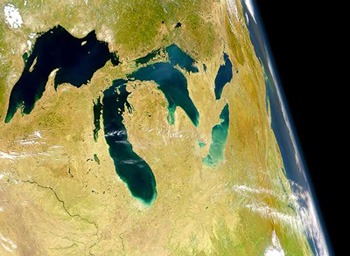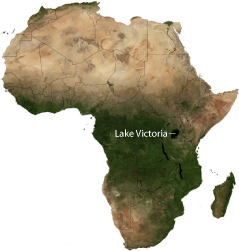
An aerial view of the Great Lakes. (Great Lakes,
SeaWIFS Project, NASA/Goddard Space Flight Center, and ORBIMAGE,
1999. http://visibleearth.nasa.gov/view_rec.php?id=1244)
|

Figure 6.3.1, Lake Victoria is located in the
continent of Africa; it is 210 miles long and 150 miles wide. (“Lake
Victoria's Falling Waters” by Holli Riebeek, March 13, 2006, Earth
Observatory, NASA.
http://earthobservatory.nasa.gov/Study/Victoria/)
|
|
The Great Lakes Basin was formed by glacier activity. The
continental glaciers repeatedly moved over what is now the Great
Lakes region as they thawed and melted. As the huge glaciers inched
forward, they scoured the surface of the earth and leveled hills.
Small valleys created by the river systems of the previous era were
deepened and enlarged to form the basins for what are now the Great
Lakes.
The Great Lakes and their connecting channels form the largest
surface freshwater system on Earth. If you stood on the moon, you
could see the lakes. The Great Lakes, in their current state, are
one of the youngest natural features on the North American
continent. Covering more than 94,000 square miles and draining more
than twice as much land, these freshwater seas hold an estimated six
quadrillion gallons of water, or about one-fifth of the world's
surface freshwater supply and nine-tenths of the US supply. Lake
Superior is the largest of the Great Lakes, and if you are measuring
surface area, is the largest freshwater lake in the world.1
|
Lake Victoria, located in Africa, is the world's second largest
freshwater lake. This lake was formed quite differently from the
Great Lakes. Its formation is connected to the development of the
Great Rift Valley that you learned about in lesson 5. As you will
recall, a rift valley is formed when two tectonic plates pull away
from one another. The lake formed in a low-lying area that developed
as the land stretched. The Nile River runs through portions of the
Great Rift Valley and receives much of its water from Lake Victoria.
The lake gets more than half of its water from rain; the rest of its
water comes from streams and rivers that empty into it.
|






